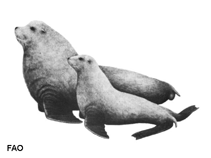Eumetopias jubatus (Schreber, 1776)
Steller's sea lion| Native range | All suitable habitat | Point map | Year 2050 |

|
| This map was computer-generated and has not yet been reviewed. |
| Eumetopias jubatus AquaMaps Data sources: GBIF OBIS |
Classification / Names Common names | Synonyms | CoL | ITIS | WoRMS
Mammalia | Carnivora | Otariidae
Environment: milieu / climate zone / depth range / distribution range Ecology
Bathydemersal. Subtropical; 90°N - 0°S, 180°W - 180°E
Distribution Countries | FAO areas | Ecosystems | Occurrences | Introductions
Pacific Ocean, Northeast Atlantic and the Arctic. Tropical to temperate.
Length at first maturity / Size / Weight / Age
Maturity: Lm ? range ? - ? cm Max length : 330 cm TL male/unsexed; (Ref. 1394); 250 cm TL (female); common length : 310 cm TL male/unsexed; (Ref. 80659); common length :240 cm TL (female); max. published weight: 1.1 t (Ref. 80659); max. published weight: 1.1 t
Short description Morphology
Life cycle and mating behavior Maturity | Reproduction | Spawning | Eggs | Fecundity | Larvae
Main reference
References | Coordinator | Collaborators
Rice, D.W. 1998 Marine Mammals of the World Systematics and Distribution. Special Publication number 4: The Society for Marine Mammalogy. 231p. (Ref. 1522)
IUCN Red List Status
(Ref. 130435: Version 2025-1)
CITES status (Ref. 108899)
CMS (Ref. 116361)
Threat to humans
Human uses
Fisheries: commercial
FAO - Fisheries: landings, species profile | FishSource | Sea Around Us
Tools
More information
Max. ages / sizes
Length-weight rel.
Length-length rel.
Length-frequencies
Mass conversion
Abundance
Internet sources
BHL | BOLD Systems | CISTI | DiscoverLife | FAO(Fisheries: species profile; publication : search) | Fishipedia | GenBank (genome, nucleotide) | GloBI | Gomexsi | Google Books | Google Scholar | Google | PubMed | Tree of Life | Wikipedia (Go, Search) | Zoological Record



